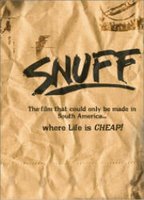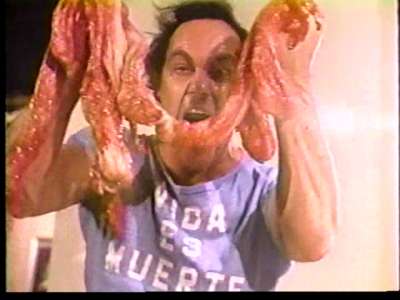Snuff
 1971 saw the release of Slaughter, a low-budget exploitation flick, filmed in Argentina and set in Argentina and Uruguay.
1971 saw the release of Slaughter, a low-budget exploitation flick, filmed in Argentina and set in Argentina and Uruguay. The film told the story of a cult led by a Mansonesque figure rejoicing in the name of Satán or Satahn. The young women who follow Satán, all hippie types with flowing hair and a predeliction for removing their blouses, are kept in servitude by a sort of sadomasochistic desire: transgressions are punished by ritual torture that is experienced as erotic pleasure and observed with voyeuristic glee.
They are therefore easily enough persuaded to kill for Satán, and spend most of the film doing just this: random strangers are murdered in airport bathrooms; knifings take place under the cover of Carnival; a corner store hold-up becomes a massacre; and so on. In a bloody climax there is the eponymous "slaughter" itself, as the group kills a Uruguayan playboy, his friend, his friend's girlfriend, his pregnant actress lover, and his German arms dealer father who, in the film's final scene, is rather inexplicably discovered in bed with his son's lover.
Slaughter was hardly a success, showing briefly in a few theatres before disappearing, apparently without trace.
Five years later, however, the film was re-released, under the new title of Snuff, and now with an extra five minutes' footage tacked on to the end.
(Albert Walker has watched and summarized the whole film, so that you don't have to, at the agony booth.)
 This new ending cuts back from the actress in bed with her lover's father, to the set on which the action is (supposedly) being filmed. Mirroring the theme (taken from what is now a film within a film) of the erotics of both violence and voyeurism, a member of the crew asks a woman, who may be either another crew member or an actress, whether she was turned on by the scene they've just shot.
This new ending cuts back from the actress in bed with her lover's father, to the set on which the action is (supposedly) being filmed. Mirroring the theme (taken from what is now a film within a film) of the erotics of both violence and voyeurism, a member of the crew asks a woman, who may be either another crew member or an actress, whether she was turned on by the scene they've just shot. Soon the two are making out on another bed conveniently located within the set, while the film's cameramen have turned to record this snippet of what is ostensibly cinema verité.
Suddenly things turn serious, as in the face of the woman's panicked protests, the male crew member gets out a knife and, while others hold his victim down, proceeds first to slice off her hand and then to disembowel her. In the movie's final shot he brandishes her entrails, before the screen goes white and briefly sprocket holes are seen as the camera runs out of film. On the soundtrack we hear the film reel come to an end and the whispered conversation of the crew: "Shit, we've run out of film! Shit!" "Did you get it? Did you get it all?" "Mmm, yeah, we got it all. Now let's get out of here."
It would seem that we have just witnessed a real murder taking place on screen.

Or such at least is the legend and mystique of Snuff. For this is the original "snuff" film (though the term had been coined to describe putative films shot by the Manson family themselves): a movie in which an actress actually dies, for the voyeuristic delight and horror of a bloodthirsty audience immune now to special effects, desiring the Real.
Nothing, of course, could be further from the truth of Snuff. The added footage quite patently bears little relation to the film whose making it apparently documents. The only continuity is that this final murder is as unconvincing and schlocky as any of the killings we have seen in the preceeding 75 minutes: it is hamfistedly shot, with obviously crude and unrealistic special effects, and enough signs of post-production and editing to reveal that it is as much a piece of fiction as what has gone before.
And yet the controversy that the film provoked upon its release, first initiated by the producer who, for instance, paid protestors to picket the cinema in which it was playing, but later picked up and amplified by both the police and the press, and that fact that, despite all the evidence to the contrary, most people simply assume that snuff films really exist, demonstrate that somehow we want to believe.
Somehow Snuff enabled this belief to become firmly instilled in popular consciousness. And surely its success, the now permanent incrustation of what was a cheap marketing trick to sell a failed horror movie, owes something also to the context of the film's production and re-release, as summarized in the movie's tagline: "A film that could only be made in South America, where life is CHEAP!"
For both Snuff the film and "snuff" the subject of rumour and gossip allude to the twin notions of a general lawlessness south of the border, and the then current political violence in the Southern Cone, as Argentina limped towards its May 1976 coup d'etat, while Uruguay and Chile were already under military regimes.
Slaughter had hardly done much with its Latin American setting: we see the actress victim arrive on a Lan Chile flight via Santiago, then phone her lover in Punta del Este encouraging him to take his motorboat across the Rio de la Plata to the San Isidro yacht club, but for instance the fact that this journey involves an international border crossing remains unaddressed. But on being re-released as Snuff in 1976, the film's violence now carries a double reference: not only to the late 1960s decay of flower power and hippiedom with the nightmare of the Mansons, but also to the political violence that would grip the Americas in the 1970s.
Snuff, in short, becomes a film about the dictatorships, and an allegory of a violence that is in plain sight, paraded before voyeuristic eyes, a violence that is real but pretends to be theatrical, mirroring the film's own violence that is so theatrical as it pretends to be real.
[Update: "The Idea of Cinema", a much longer essay on Snuff, and on snuff.]
Labels: geopolitics, horror